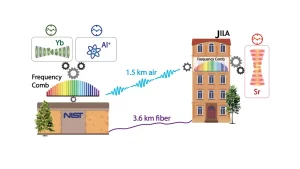Optical lattice clocks importance and drawbacks, What is the most accurate clock in the universe?
The lattice clock is an advanced atomic clock that uses laser-cooled atoms trapped in an optical lattice to measure time with extreme precision. It is one of the most accurate timekeeping devices ever developed, surpassing traditional cesium atomic clocks.
What is a lattice clock?
The lattice clock is an ultra-precise atomic clock that uses laser-cooled atoms trapped in an optical lattice to measure time with extreme accuracy. These clocks operate using the vibrations of atoms—typically strontium (Sr) or ytterbium (Yb)—which oscillate at optical frequencies (hundreds of terahertz).
The lattice clock measures time with an error of 1 second in billions of years. It operates at frequencies in the hundreds of terahertz, far more precise than microwave-based cesium clocks. It traps thousands of atoms at once, increasing stability and reducing noise. It can detect gravitational time dilation, confirming Einstein’s theories.
Optical lattice clocks are more stable than cesium atomic clocks (the current standard for defining the second). Due to their precision, lattice clocks could replace cesium clocks for international timekeeping. They help test Einstein’s relativity and search for new physics, such as variations in fundamental constants.
How a Lattice Clock Works
- Atoms (usually strontium (Sr) or ytterbium (Yb)) are cooled to near absolute zero using laser beams and trapped in an optical lattice (a standing wave of laser light).
- A standing laser light wave creates a stable trap that holds the atoms in place, minimizing motion-related errors.
- A highly stable laser excites electrons in the trapped atoms, causing them to oscillate between energy levels at a well-defined optical frequency.
- The frequency of these atomic oscillations is used as an ultra-precise time standard. These oscillations are used as a timekeeping reference, similar to how a pendulum regulates a mechanical clock, but at a much higher frequency.
Applications of Lattice Clocks
- Lattice Clocks may soon replace cesium clocks as the official time standard.
- Lattice Clock enhances the accuracy of the global positioning system (GPS).
- Lattice Clock measures gravitational potential differences for altitude and sea level monitoring.
- Lattice Clocks are used in dark matter detection, quantum mechanics research, and testing the stability of physical constants.
- Lattice Clock provides accurate timing for space missions and interplanetary navigation.
Features of a Lattice Clock
- Lattice Clocks can measure time with an accuracy of 1 second in billions of years, far surpassing cesium atomic clocks.
- Lattice Clock operates at optical frequencies (hundreds of terahertz), making it much more precise than microwave-based atomic clocks.
- Lattice Clock uses laser cooling to slow down and trap atoms (usually strontium (Sr) or ytterbium (Yb)) to minimize atomic motion and improve measurement accuracy.
- Atoms are trapped in a standing wave of laser light, preventing movement-related errors and allowing multiple atoms to be measured simultaneously.
- Due to the precise trapping of atoms and advanced laser stabilization, systematic errors are significantly reduced.
- Lattice Clock helps in gravitational time dilation studies, dark matter research, and fundamental constant variation tests.
- Lattice Clock is expected to replace cesium clocks as the new standard for timekeeping in the future.
- Lattice Clock can detect minute gravitational variations on Earth, enabling precise measurements of altitude differences and changes in Earth’s shape.
Advantages of Lattice Clocks
Optical lattice clocks are 100 times more accurate than cesium atomic clocks, with errors of only 1 second in billions of years. They provide highly stable frequency measurements, improving timekeeping consistency. Their precision makes them strong candidates to replace cesium clocks as the primary time standard.
Optical lattice clocks are useful for studying gravitational time dilation (Einstein’s relativity), dark matter searches, and fundamental constant variations. They improve the Global Positioning System (GPS), and they could enhance navigation systems by reducing timing errors. They can detect tiny gravitational differences, helping in mapping Earth’s shape and measuring height variations with extreme precision.
Disadvantages of Lattice Clocks
Optical lattice clocks require advanced laser cooling, vacuum systems, and stable lasers, making them expensive to build and maintain. They require specialized expertise to operate, making widespread deployment difficult. While improving, lattice clocks are still larger than traditional atomic clocks and not yet portable for field use.
Optical lattice clocks require ultra-stable lasers and high-power sources, which add to operational challenges. Currently, their precision exceeds the needs of most real-world applications, meaning they are mainly used for research rather than everyday timekeeping.
Uses of a Lattice Clock
- Timekeeping & Redefining the Second: Optical lattice clocks are so precise that they may replace cesium atomic clocks as the primary standard for measuring time. They help maintain Coordinated Universal Time (UTC) with higher accuracy.
- Fundamental Physics Research: Optical lattice clocks test Einstein’s theory of relativity by detecting tiny time distortions due to gravity (gravitational time dilation). They also help search for dark matter and test variations in fundamental physical constants.
- Global Navigation and Positioning (GPS/GNSS): More precise timekeeping can improve GPS accuracy, and reduce errors in global positioning systems.
- Geodesy (Earth Measurements): Optical lattice clocks help measure gravitational potential differences, allowing the detection of small altitude changes (useful for earthquake predictions, sea level monitoring, and climate change studies).
- Communications & Data Networks: Ultra-precise timing enhances telecommunications, financial transactions, and data synchronization in global networks.
- Deep Space Navigation: Optical lattice clocks could improve spacecraft navigation by providing more accurate timing signals for interplanetary missions.
You can follow Science Online on Youtube from this link: Science online
What are the importance of atomic clocks and How do Atomic Clocks work?
What are the advantages and disadvantages of using the Internet?
Global Positioning System (GPS Tracking System) advantages and disadvantages
Global Navigation Satellite System (GNSS) types, use & importance
What are the importance and uses of Satellites in our life?
Idea of launching the satellite & Factors affecting orbital velocity of a satellite
Extranet review, features, use, advantages and disadvantages
Intranet advantages, disadvantages, How do Intranet, Internet, and Extranet differ?
Benefits & application of Artificial intelligence in business, E-commerce and marketing
Online marketing uses, advantages and disadvantages
What are the advantages and disadvantages of Internet banking?




